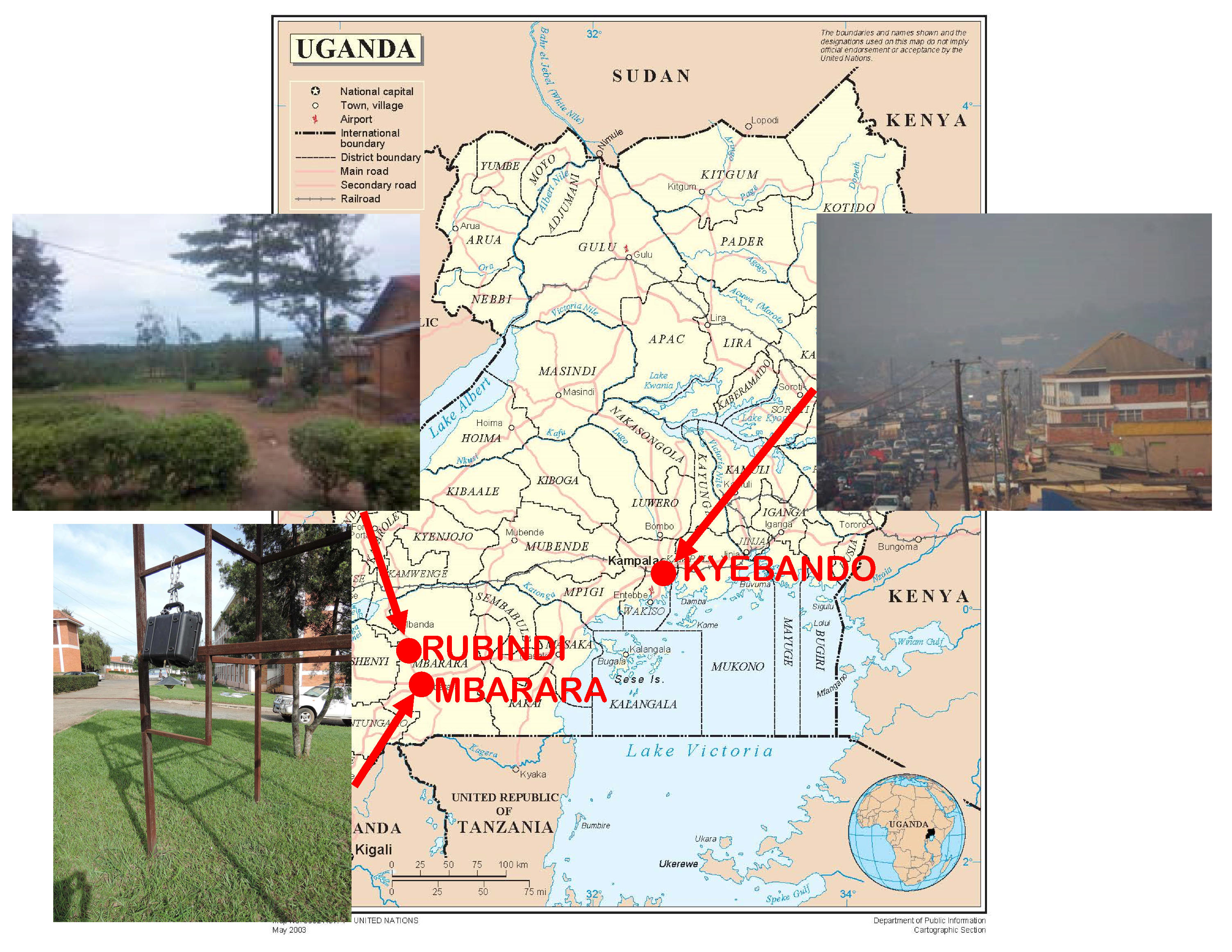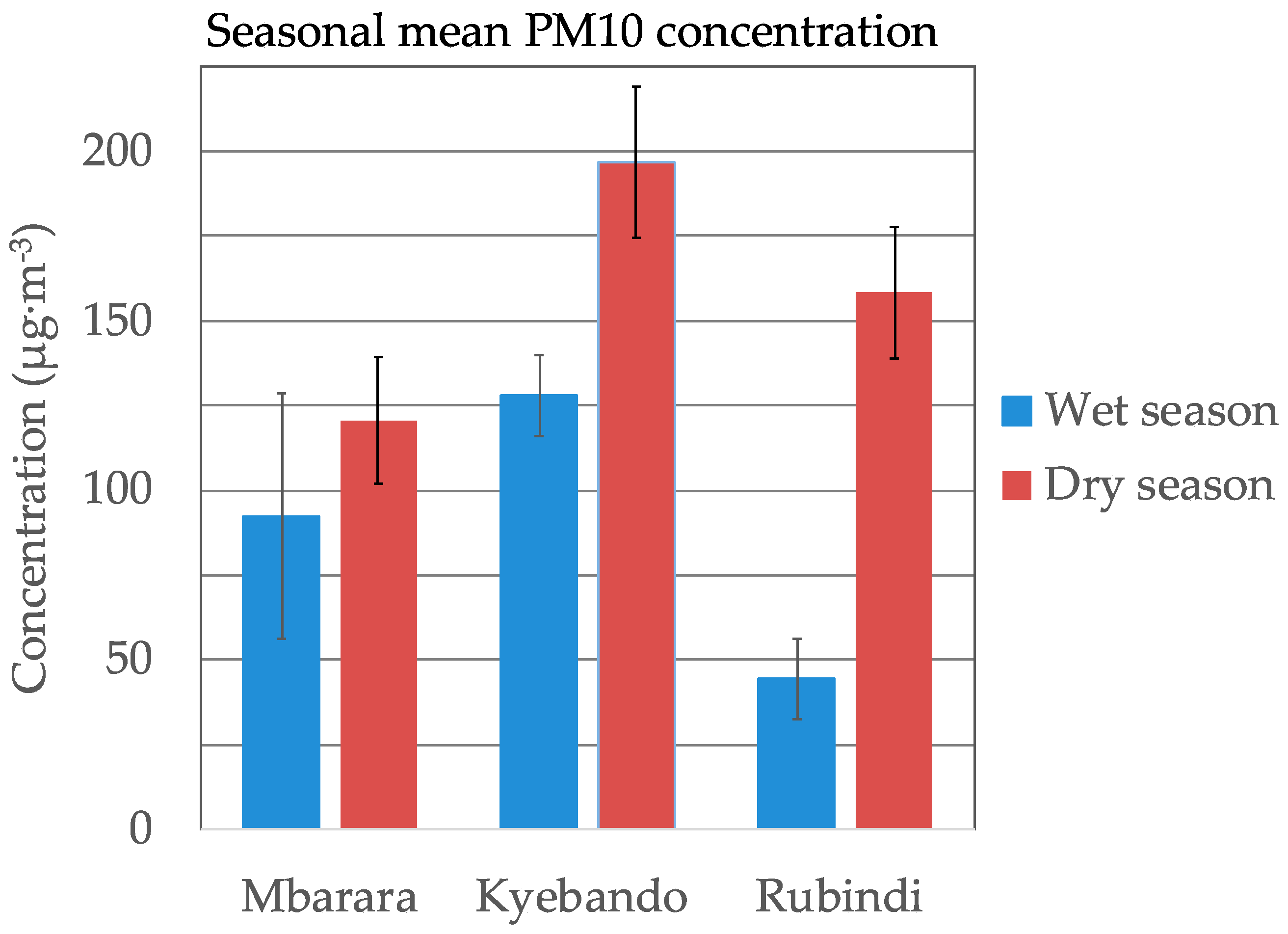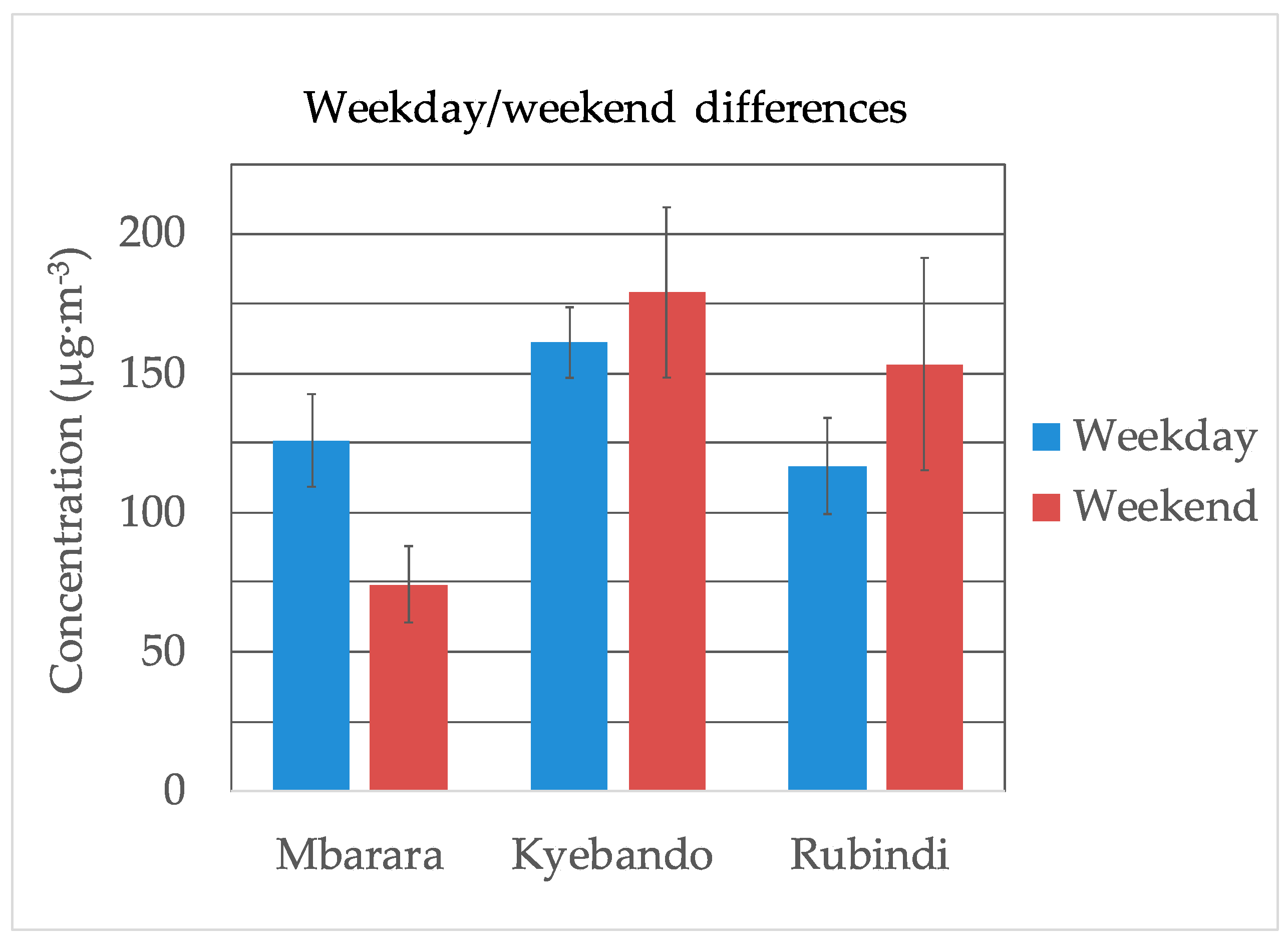Spatio-Temporal Variation in the Concentration of Inhalable Particulate Matter (PM10) in Uganda
Abstract
:1. Introduction
2. Materials and Methods
2.1. Study Area and Sampling Sites
2.2. Sample Collection and Preparation
2.3. Data Preparation
2.4. Ethical Approval
3. Results
3.1. Spatial Variations in Air Quality
3.2. Seasonal Differences in Air Quality
3.3. Weekday/Weekend Differences in Air Quality
3.4. Diurnal Variations
4. Discussion
4.1. Air Quality and Spatial Differences
4.2. Seasonal Differences
4.3. Weekday/Weekend Differences
4.4. Diurnal Variations
5. Conclusions
Supplementary Materials
Author Contributions
Funding
Conflicts of Interest
References
- Ambient (Outdoor) Air Quality and Health. Available online: https://www.who.int/news-room/fact-sheets/detail/ambient-(outdoor)-air-quality-and-health (accessed on 16 Janary 2019).
- Kim, K.-H.; Kabir, E.; Kabir, S. A review on the human health impact of airborne particulate matter. Environ. Int. 2015, 74, 136–143. [Google Scholar] [CrossRef]
- Pope, C.A.; Dockery, D.W. Health Effects of Fine Particulate Air Pollution: Lines that Connect. J. Air Waste Manag. Assoc. 2006, 56, 709–742. [Google Scholar] [CrossRef] [PubMed] [Green Version]
- Rice, M.B.; Ljungman, P.L.; Wilker, E.H.; Dorans, K.S.; Gold, D.R.; Schwartz, J.; Koutrakis, P.; Washko, G.R.; O’Connor, G.T.; Mittleman, M.A. Long-Term Exposure to Traffic Emissions and Fine Particulate Matter and Lung Function Decline in the Framingham Heart Study. Am. J. Respir. Crit. Care Med. 2015, 191, 656–664. [Google Scholar] [CrossRef] [PubMed] [Green Version]
- Hoek, G.; Krishnan, R.M.; Beelen, R.; Peters, A.; Ostro, B.; Brunekreef, B.; Kaufman, J.D. Long-term air pollution exposure and cardio- respiratory mortality: A review. Environ. Health 2013, 12, 43. [Google Scholar] [CrossRef]
- Schwartz, J.; Alexeeff, S.E.; Mordukhovich, I.; Gryparis, A.; Vokonas, P.; Suh, H.; Coull, B.A. Association between long-term exposure to traffic particles and blood pressure in the Veterans Administration Normative Aging Study. Occup. Environ. Med. 2012, 69, 422–427. [Google Scholar] [CrossRef] [Green Version]
- Kelly, F.J.; Fussell, J.C. Air pollution and public health: Emerging hazards and improved understanding of risk. Environ. Geochem. Health 2015, 37, 631–649. [Google Scholar] [CrossRef] [PubMed]
- Kirenga, B.; Meng, Q.; van Gemert, F.; Aanyu-Tukamuhebwa, H.; Chavannes, N.; Katamba, A.; Obai, G.; Molen, T.; Schwander, S.; Mohsenin, V. The State of Ambient Air Quality in Two Ugandan Cities: A Pilot Cross-Sectional Spatial Assessment. Int. J. Environ. Res. Public Health 2015, 12, 8075–8091. [Google Scholar] [CrossRef] [Green Version]
- Jovanelly, T.J.; Okot-Okumu, J.; Nyenje, R.; Namaganda, E. Comparative Assessment of Ambient Air Standards in Rural Areas to Uganda City Centers. J. Public Health Dev. Ctries. 2017, 3, 371–380. [Google Scholar]
- Schwander, S.; Okello, C.D.; Freers, J.; Chow, J.C.; Watson, J.G.; Corry, M.; Meng, Q. Ambient Particulate Matter Air Pollution in Mpererwe District, Kampala, Uganda: A Pilot Study. J. Environ. Public Health 2014, 2014, 763934. [Google Scholar] [CrossRef]
- Kirenga, B.; Nantanda, R.; de Jong, C.; Mugenyi, L.; Meng, Q.; Aniku, G.; Williams, S.; Aanyu-Tukamuhebwa, H.; Kamya, M.; Schwander, S.; et al. Lung Function of Children at Three Sites of Varying Ambient Air Pollution Levels in Uganda: A Cross Sectional Comparative Study. Int. J. Environ. Res. Public Health 2018, 15, 2653. [Google Scholar] [CrossRef]
- Statistical Abstract. 2017. Available online: https://www.ubos.org/wp-content/uploads/publications/03_20182017_Statistical_Abstract.pdf (accessed on 14 May 2019).
- Mukwaya, P.I.; Sengendo, H.; Lwasa, S. Urban development transitions and their implications for poverty reduction and policy planning in Uganda. Urban Forum 2010, 21, 267–281. [Google Scholar] [CrossRef]
- Mkoma, S.L.; Maenhaut, W.; Chi, X.; Wang, W.; Raes, N. Characterisation of PM10 atmospheric aerosols for the wet season 2005 at two sites in East Africa. Atmos. Environ. 2009, 43, 631–639. [Google Scholar] [CrossRef]
- Mkoma, S.L.; Chi, X.; Maenhaut, W. Characteristics of carbonaceous aerosols in ambient PM10 and PM2.5 particles in Dar es Salaam, Tanzania. Sci. Total Environ. 2010, 408, 1308–1314. [Google Scholar] [CrossRef] [PubMed]
- Van Vliet, E.D.S.; Kinney, P.L. Impacts of roadway emissions on urban particulate matter concentrations in sub-Saharan Africa: New evidence from Nairobi, Kenya. Environ. Res. Lett. 2007, 2, 045028. [Google Scholar] [CrossRef]
- Gaita, S.M. Airborne Particulate Matter in a Sub-Saharan Africa City: Nairobi, Kenya, and at an Equatorial High Altitude Site: Mount Kenya. Ph.D. Thesis, University of Gothenburg, Gothenburg, Sweden, 2017. [Google Scholar]
- Amegah, A.K.; Agyei-Mensah, S. Urban air pollution in Sub-Saharan Africa: Time for action. Environ. Pollut. 2017, 220, 738–743. [Google Scholar] [CrossRef] [PubMed]
- Owili, P.; Lien, W.-H.; Muga, M.; Lin, T.-H. The Associations between Types of Ambient PM2.5 and Under-Five and Maternal Mortality in Africa. Int. J. Environ. Res. Public Health 2017, 14, 359. [Google Scholar] [CrossRef]
- Petkova, E.P.; Jack, D.W.; Volavka-Close, N.H.; Kinney, P.L. Particulate matter pollution in African cities. Air Qual. Atmos. Health 2013, 6, 603–614. [Google Scholar] [CrossRef]
- Tanimowo, M.O. Air pollution and respiratory health in Africa: A review. East Afr. Med. J. 2000, 77, 71–75. [Google Scholar] [CrossRef] [PubMed]
- Dotse, S.-Q.; Asane, J.K.; Ofosu, F.G.; Aboh, I.J.K. Particulate Matter and Black Carbon Concentration Levels in Ashaiman, a Semi-Urban Area of Ghana, 2008. Res. J. Environ. Earth Sci. 2012, 4, 20–25. [Google Scholar]
- Mkoma, S.L.; Mjemah, I.C. Influence of Meteorology on Ambient Air Quality in Morogoro, Tanzania. Int. J. Environ. Sci. 2011, 1, 1107–1115. [Google Scholar]
- Mkoma, S.L.; Kawamura, K.; Fu, P.Q. Contributions of biomass/biofuel burning to organic aerosols and particulate matter in Tanzania, East Africa, based on analyses of ionic species, organic and elemental carbon, levoglucosan and mannosan. Atmos. Chem. Phys. 2013, 13, 10325–10338. [Google Scholar] [CrossRef] [Green Version]
- Egondi, T.; Muindi, K.; Kyobutungi, C.; Gatari, M.; Rocklöv, J. Measuring exposure levels of inhalable airborne particles (PM 2.5) in two socially deprived areas of Nairobi, Kenya. Environ. Res. 2016, 148, 500–506. [Google Scholar] [CrossRef] [PubMed]
- Pope, F.D.; Gatari, M.; Ng’ang’a, D.; Poynter, A.; Blake, R. Airborne particulate matter monitoring in Kenya using calibrated low-cost sensors. Atmos. Chem. Phys. 2018, 18, 15403–15418. [Google Scholar] [CrossRef]
- Kiggundu, A.T. An Assessment of the Capabilities and Gaps in Urban Air Quality Management in Uganda. Sci-Afric J. Sci. Issues Res. Essays 2015, 3, 616–628. [Google Scholar]
- Uganda Map. Available online: http://www.un.org/Depts/Cartographic/map/profile/uganda.pdf (accessed on 17 May 2019).
- Scapellato, M.; Tessari, R.; Bonfiglio, E.; Benassi, A.; Tieppo, P.; De Bortoli, A.; Serraino, S.; Carrieri, M.; Maccà, I.; Gori, G.; et al. Validation of PM10 and PM2.5 personal samplers: Comparison between PEM and CEN-ARPAV selectors. G. Ital. Med. Lav. Ergon. 2005, 27, 362–366. [Google Scholar] [PubMed]
- Model 200 Personal Environmental Monitor (PEM) User Guide. Available online: https://www.tsi.com/products/aerosol-and-dust-monitors/dust-monitors/personal-impactors-200-series/ (accessed on 17 May 2019).
- SidePak Personal Aerosol Monitor Model AM510 User Guide. Available online: https://www.tsi.com/discontinued-products/sidepak-personal-aerosol-monitor-am510/ (accessed on 17 May 2019).
- Muyanja, D.; Allen, J.G.; Vallarino, J.; Valeri, L.; Kakuhikire, B.; Bangsberg, D.R.; Christiani, D.C.; Tsai, A.C.; Lai, P.S. Kerosene lighting contributes to household air pollution in rural Uganda. Indoor Air 2017, 27, 1022–1029. [Google Scholar] [CrossRef]
- Blanchard, C.L.; Tanenbaum, S.J. Differences between Weekday and Weekend Air Pollutant Levels in Southern California. J. Air Waste Manag. Assoc. 2003, 53, 816–828. [Google Scholar] [CrossRef] [Green Version]
- Karar, K.; Gupta, A.K.; Kumar, A.; Biswas, A.K.; Devotta, S. Statistical Interpretation of Weekday/Weekend Differences of Ambient Particulate Matter, Vehicular Traffic and Meteorological Parameters in an Urban Region of Kolkata, India. Indoor Built Environ. 2006, 15, 235–245. [Google Scholar] [CrossRef]
- Khoder, M.I.; Hassan, S.K. Weekday/weekend differences in ambient aerosol level and chemical characteristics of water-soluble components in the city centre. Atmos. Environ. 2008, 42, 7483–7493. [Google Scholar] [CrossRef]
- Choi, Y.-S.; Ho, C.-H.; Chen, D.; Noh, Y.-H.; Song, C.-K. Spectral analysis of weekly variation in PM10 mass concentration and meteorological conditions over China. Atmos. Environ. 2008, 42, 655–666. [Google Scholar] [CrossRef]
- Lin, G.; Fu, J.; Jiang, D.; Hu, W.; Dong, D.; Huang, Y.; Zhao, M. Spatio-Temporal Variation of PM2.5 Concentrations and Their Relationship with Geographic and Socioeconomic Factors in China. Int. J. Environ. Res. Public Health 2013, 11, 173–186. [Google Scholar] [CrossRef] [Green Version]
- Liu, Z.; Hu, B.; Wang, L.; Wu, F.; Gao, W.; Wang, Y. Seasonal and diurnal variation in particulate matter (PM10 and PM2.5) at an urban site of Beijing: Analyses from a 9-year study. Environ. Sci. Pollut. Res. 2015, 22, 627–642. [Google Scholar] [CrossRef] [PubMed]
- Chow, J.C.; Watson, J.G.; Green, M.C.; Lowenthal, D.H.; DuBois, D.W.; Kohl, S.D.; Egami, R.T.; Gillies, J.; Rogers, C.F.; Frazier, C.A.; et al. Middle- and Neighborhood-Scale Variations of PM10 Source Contributions in Las Vegas, Nevada. J. Air Waste Manag. Assoc. 1999, 49, 641–654. [Google Scholar] [CrossRef] [PubMed]
- WHO Air Quality Guidelines for Particulate Matter, Ozone, Nitrogen Dioxide and Sulfur Dioxide Global Update 2005: Summary of Risk Assessment. Available online: https://apps.who.int/iris/handle/10665/69477 (accessed on 17 May 2019).




| Site | N | Mean ± SD | Min | 25th Percentile | Median | 75th Percentile | Max |
|---|---|---|---|---|---|---|---|
| Mbarara | 30 | 116 ± 14 | 30 | 57 | 98 | 144 | 361 |
| Kyebando | 29 | 167 ± 13 | 50 | 124 | 167 | 184 | 399 |
| Rubindi | 28 | 130 ± 17 | 17 | 72 | 115 | 167 | 477 |
| Site | N | Mean Daytime (10:00 to 18:00) | Mean Overnight (19:00 to 09:00) | t-Value | p-Value |
|---|---|---|---|---|---|
| Mbarara | 39 | 66 | 107 | −9.007 | 0.000 |
| Kyebando | 25 | 77 | 151 | −6.872 | 0.000 |
| Rubindi | 30 | 64 | 80 | −5.603 | 0.000 |
| Site | N | Mean ± SD (Gravimetric) | Mean ± SD (Light Scattering) |
|---|---|---|---|
| Mbarara | 29 | 116 ± 14 | 93 ± 10 |
| Kyebando | 20 | 173 ± 17 | 128 ± 12 |
| Rubindi | 24 | 136 ± 20 | 75 ± 9 |
© 2019 by the authors. Licensee MDPI, Basel, Switzerland. This article is an open access article distributed under the terms and conditions of the Creative Commons Attribution (CC BY) license (http://creativecommons.org/licenses/by/4.0/).
Share and Cite
Onyango, S.; Parks, B.; Anguma, S.; Meng, Q. Spatio-Temporal Variation in the Concentration of Inhalable Particulate Matter (PM10) in Uganda. Int. J. Environ. Res. Public Health 2019, 16, 1752. https://doi.org/10.3390/ijerph16101752
Onyango S, Parks B, Anguma S, Meng Q. Spatio-Temporal Variation in the Concentration of Inhalable Particulate Matter (PM10) in Uganda. International Journal of Environmental Research and Public Health. 2019; 16(10):1752. https://doi.org/10.3390/ijerph16101752
Chicago/Turabian StyleOnyango, Silver, Beth Parks, Simon Anguma, and Qingyu Meng. 2019. "Spatio-Temporal Variation in the Concentration of Inhalable Particulate Matter (PM10) in Uganda" International Journal of Environmental Research and Public Health 16, no. 10: 1752. https://doi.org/10.3390/ijerph16101752
APA StyleOnyango, S., Parks, B., Anguma, S., & Meng, Q. (2019). Spatio-Temporal Variation in the Concentration of Inhalable Particulate Matter (PM10) in Uganda. International Journal of Environmental Research and Public Health, 16(10), 1752. https://doi.org/10.3390/ijerph16101752





